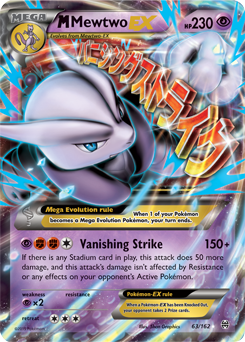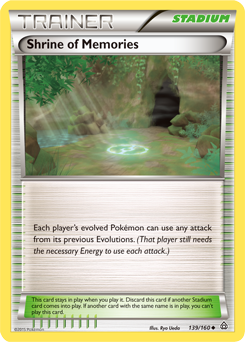Three Off-Beat Deck Choices for the Last Weekend of Cities!
Hello again PokeBeach! I’m back for my second article as part of the premium article program. I hope you enjoyed my last efforts and are having a successful Cities season! As for myself, I’ve only been able to attend one so far, but I’m looking forward to playing in States and hopefully Winter Regionals. I forgot to include this information in my last article, but you can follow me on Twitter and Twitch.

Are you growing tired of your current deck choices? Not making cut with Night March anymore? Yveltal letting you down? Vespiquen not as thrilling as it used to be? Well, today I’ll be talking about a couple decks that I will be choosing between for the last weekend of Cities. Although I haven’t played in many Cities, I’ve been frivolously thinking about Pokemon and talking about the format with friends. My goal in this article is to shed some light on a few lesser-played decks that are surprisingly strong despite their small showing during Cities. They’re a little bit outside the box, so bear with me. If you’re tired of playing the same old thing, try one of these out. All three of these lists have been tested and proven by other people and me to some excellent results. You won’t be disappointed!
The Element of Surprise
One unfortunate thing about the card game we all love so much, it can quickly become stale and predictable at times. While we do have a large card pool to craft decks from at the moment, there are always archetypes that will rise to the top. Not only do certain decks rise to the top, but even specific lists become more frequently seen than others. This isn’t simply because some decks are good and some are bad. It’s because some decks are played more than others, sometimes by a large margin. When a deck is played more, naturally, it will have more positive recorded results than a deck that is played less. For this reason, to determine a deck or list’s worth, it’s necessary to look at not only its placings but the frequency at which it appears in competitive play. I’m not saying that things like tier lists are completely invalid, but I am saying they are merely a guideline as to what’s being played.
The efficacy of certain cards in certain formats is undeniable, and the combination and synergy of certain strategies are often too strong to be denied. Virizion-EX / Genesect-EX is an example of a deck that was played in very high volume, consistently displayed top placings throughout the multiple formats it was legal, and even won the 2014 World Championship’s Masters division. On the other side of the spectrum, The Truth — a rogue deck created by Ross Cawthon — made it to the finals of the 2011 World Championships in the Masters division. This proves decks that may not be part of the meta are just as competitive, if not more competitive, than the more commonly played decks.
In summation, a deck doing well in a particular format isn’t inherently strong. There are mitigating factors, one of which is frequency of play. This article is focused on three decks that have strong finishes when compared to how little they appear in tournaments.
Damage Change
First, I’ll talk about a deck I’ve been wanting to play every since I heard about it: M Mewtwo-EX / Shrine of Memories. It first popped up at a few European Regionals in the fall, and seems like an interesting concept and is actually really powerful.
The idea is to set up M Mewtwo-EX X or M Mewtwo-EX Y using Sableye, Landorus, Smeargle, and Mega Turbo to accelerate Energy. Instead of focusing on any of the Mega’s attacks, the deck uses Shrine of Memories to access the basic Mewtwo-EX‘s attack, Damage Change. Since Mewtwo is a tank with a high HP, the goal is to keep it alive by continuously moving the damage away from it, a similar strategy to The Truth, which I mentioned earlier. Most of the time, the opponent will be forced to hit into Mewtwo without Knocking it Out. If they don’t deal enough damage to simply die from Damage Swap, it can be followed up by any of the Mega’s attacks for the KO next turn.
Pokemon
Mewtwo-EX
Mewtwo’s expired EX form dominated almost every format it was in. It was played as at least a one-of in every deck since it came out in Next Destinies. Where the new Mewtwo-EX lacks splashability, it makes up for in versatility. It’s still weak to Psychic, which isn’t as big of a problem without an opposing X Ball around every corner. Night March does hit this Weakness, but we will discuss that issue later. Three copies helps us get Mewtwo on the field early in the game to start attaching Energy to it.
M Mewtwo-EX (X)

Mewtwo has two different Megas, one for its Y form and one of its X. The reason we play two of this version is because we are using the regular Mewtwo’s attack most of the time, and M Mewtwo-EX X’s whopping 230 HP plays right into this strategy. 230 HP allows it to survive pretty much any attack in the format, with the exception of OHKOs from Night March and Vespiquen. That’s not to say Vanishing Strike isn’t a premium attack. There will likely be a Stadium in play for it since this deck plays five of them, not even taking into account the fact that every other deck plays its own Stadiums. It’s also not affected by Resistance or any other effects on your opponent’s Pokemon, meaning it tears through cards like Hard Charm with ease.
M Mewtwo-EX (Y)
The other version of M Mewtwo-EX boasts a stronger attack. Psychic Infinity is reminiscent of the X Ball of old. TPCI learned their lesson, however, and the attack isn’t affected by Weakness. It’s still dang good against Energy-hogging Pokemon, and gives you another option on how you want to deal damage. It is slightly more fragile than M Mewtwo-EX, as it “only” has 210 HP.
Sableye
Now that we have our main attackers, we are in need of a way to power them up quickly. Manual attachments won’t do the job on their own. That’s where Sableye comes in. Although many people would turn to a higher count of Landorus, I chose to build my deck around Sableye because, even though I could technically flip three tails when using Sableye’s Energy Hunt, the reward of attaching two or three Energy is worth the risk.
Landorus
Just in case our flippy plan backfires, we do play one Landorus. Better safe than sorry. Shout of Power gets a guaranteed Energy attachment, and Landorus’s HP trumps Sableye‘s 120 to 70, allowing it to possibly live through more than one turn.
Smeargle
But wait, we have another way to match this deck’s bizarre Energy cost! Since Damage Change requires multiple Psychic Energy and Vanishing Strikes requires Fighting, Smeargle can simply exchange one for the other, depending on which attack we need to use that turn. We only play one because, with all the Energy acceleration options we have, it’s not necessary for every situation near the end of the game.
Hoopa-EX
We have quite the variety of Pokemon here, making Hoopa-EX a big help when setting up our board early on. We can get two Mewtwo-EX and a Mega and start swinging by turn two. If needed, for three Psychic Energy, Hoopa can snipe any of our opponent’s Pokemon for 100. The only problem I have been having with this card is when it is trapped Active. With only one switch effect in the deck it can cause some problems. I have considered cutting it from the deck due to this issue, despite the consistency boost it brings to the table.
Supporters
Professor Sycamore / Professor Birch’s Observations
We don’t run too many Supporters, but we do want to draw through it reliably. It’s okay to discard resources like Energy since we have multiple ways to get them back from the discard.
Korrina
I originally played a Skyla in this spot, but I realized that Korrina not only gets an Item, but can grab Landorus for free. Once Korrina is in your discard, you can reuse it to get those crucial one-of Items like Tool Retriever and Weakness Policy out of the deck, as well as consistency cards like Ultra Ball, Trainers' Mail, and Mega Turbo.
Lysandre
If Damage Swap doesn’t OHKO the Defending Pokemon, our opponent can just retreat it. In this case, we can either snipe it with Hoopa-EX or, as a more reliable option, pull it back up with Lysandre and use a Mega Mewtwo’s attack to finish it off.
Trainers
VS Seeker / Trainers’ Mail / Ultra Ball
We play a maxed out count of all three to consistently set up our board. I can’t stress enough how crucial a deck’s consistency engine is. If we skimp on these counts, it will come back to haunt us with many unplayable hands and pathetic games lasting only a few turns. A deck that doesn’t set up is no deck at all.
Battle Compressor
Battle Compressor helps us get our Energy in the discard early on so we can start using Sableye, Landorus, Smeargle, and Mega Turbo as early as turn two. As always, it’s great for thinning the deck and putting one-of Supporters in the discard to be retrieved with VS Seeker. After the deck is fully setup, Battle Compressor can also be used to discard cards such as Landorus or Hoopa-EX that the deck only needs in the early game.
Mega Turbo
Mega Mewtwo — and all Megas in general — is an Energy hog. Four Mega Turbo helps us feed the beast. If we need to get an attack powered up in one turn without the use of Sableye or Landorus, Mega Turbo can take care of that job. Taking a basic Energy from the discard and attaching it to a Mega without using up our attachment for the turn helps mitigate the high Energy costs of all our attacks.

Shrine of Memories
This is one of the key cards in the deck. It allows us to use Damage Change with Mega Mewtwo. Without it, we would be stuck with only Vanishing Strike and Psychic Infinity, which aren’t going to cut it in many situations. It’s important to keep in mind that Shrine of Memories works for our opponents as well. This won’t be much of an issue in most matchups outside of some random decks. Most decks won’t be interested in using the attacks of the lesser forms of their Pokemon, and the BREAK cards can use them regardless of the Stadium. We have four copies to ensure that we’ll always have it to replace a counter Stadium. Basically, we need to use this Stadium almost every turn.
Dimension Valley
If, for some reason, we can’t get quite enough Energy to use Vanishing Strike, we can use Dimension Valley as an alternative, making the attack cost one less Energy and also fulfilling the Stadium requirement of the attack. It’s here as an another option, most likely to pull off the final attack of the game. We have to make sure not to play it down against Night March unless it’s to finish the game, or they can take advantage of it as well.
Mewtwo Spirit Link
This inclusion is common sense. Not ending our turn when evolving to Mega Mewtwo allows us to attack in the same turn we play it down, dishing out some quick damage early in the game or saving our board in the late game. We want to have Mewtwo swinging as early as possible and we don’t want to have its weaker non-Mega form getting KO’d too early in the game. The only problem with this is we can’t take advantage of another Tool… or can we?
Tool Retriever
Tool Retriever allows us to remove the Spirit Link from Mega Mewtwo once it’s already evolved. Then we are free to attach either Hard Charm or Weakness Policy, depending on the situation. Tools are relatively important to this deck and each one has its niche.
Hard Charm
Although M Mewtwo-EX X’s HP is already sky-high, with Hard Charm it increases to a ridiculous 250. This allows it to soak up even more damage before transferring it back to the Defending Pokemon. It can also give M Mewtwo-EX Y a nice bump up to 230, increasing its tankability as well. These numbers are harder for Vespiquen and Night March to reach, so hopefully the extra 20 HP will save us in those hairy situations.
Weakness Policy
Remember when I said we would talk about Night March? Well, here’s our solution, if it can be called that. It’s much more difficult for Night March to OHKO Mega Mewtwo without using Weakness to Pumpkaboo‘s advantage. We have to be careful to make this strategy effective, since there is only one Weakness Policy in the deck. Once we have evolved Mewtwo with Spirit Link we can use Korrina or just happen across our Weakness Policy. If lists in your area favor Xerosic, this card could be bumped up to a two-of or, if you’d rather not worry about teching for a difficult matchup at all, eliminated entirely.
Escape Rope
We don’t play very many ways to retreat, but hopefully we can power up and attack with almost anything in play. If attacking with whatever is pulled up is too much of an inconvenience, Escape Rope helps us retreat whatever gets stuck Active. For example, Landorus is a bit beefy, so it has a tendency to stay in the Active spot. Escape Rope makes sure we don’t lose a turn of attacking with Mewtwo. We play it over Switch so we can damage targets our opponent is keeping safe on the Bench and force them into an awkward situation.
Matchups
Manectric-EX decks are an excellent matchup for this deck as they have no way to OHKO Mewtwo. We are free to sit back and use Damage Change to our heart’s content with no fear of anything blowing our head off. Yveltal / Zoroark is a good matchup for similar reasons. Yveltal-EX struggles to pile on enough Energy to deal a clean 260 and, although Zoroark BREAK can copy M Mewtwo-EX X’s attack, 200 damage still isn’t enough to KO the Psychic Cat. Entei is a positive matchup for this reason as well. The lack of Special Energy give the deck a natural advantage over Giratina-EX. Lucario-EX / Crobat is an easy matchup as well, and Damage Change goes through Focus Sash. Essentially, any deck that can’t OHKO Mega Mewtwo is going to be relatively positive for the deck.
Negative matchups include Night March and Vespiquen because they are capable of reaching high damage thresholds. While they are easy to return KO, the trade isn’t favorable, and, since Mewtwo requires so much setup, they will probably set up faster than us. Weakness Policy can come in clutch against Pumpkaboo. If we can get the Damage Change lock going, it may be enough to save the matchup.
Giant Plants
This innovative list was first piloted by Andrew Wamboldt at the Chicago Marathon. After trying it out myself, I quickly saw the incredible power it was capable of. The goal here is to get out a turn one Vileplume. If we go first, getting out the smelly plant will put us in a great position from the get-go. Therefore, the list is built to be extremely consistent. It’s possible and even relatively easy to get out both Vileplume and Vespiquen, blocking our opponent’s Trainers and threatening a high damage output. Let’s take a closer look at the cards Andrew included in his list and see how they all fit together.
This concludes the public portion of this article.
If you'd like to continue reading, consider purchasing a PokeBeach premium membership! If you're not completely satisfied with your membership, you can request a full refund within 30 days.
Each week we post high-quality content from some of the game's top players. Our article program isn't a corporate operation, advertising front, or for-profit business. We set our prices so that we can pay the game's top players to write the best content for our subscribers. Each article topic is carefully selected, goes through multiple drafts, and is touched up by our editors. We take great pride in our program!

